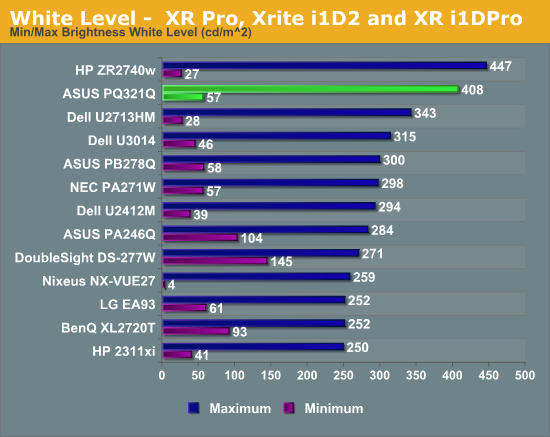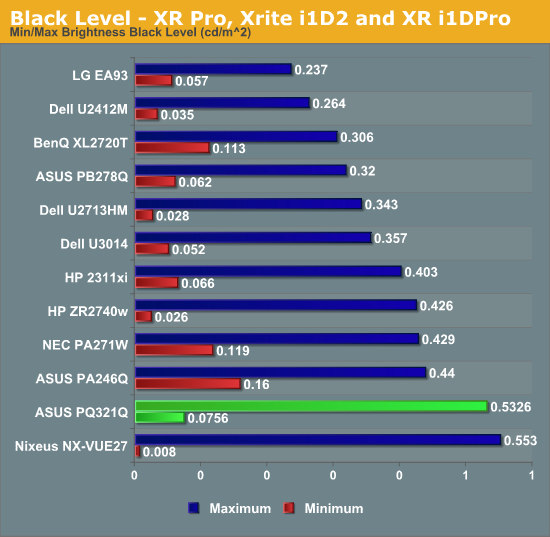ASUS PQ321Q UltraHD Monitor Review: Living with a 31.5-inch 4K Desktop Display
by Chris Heinonen on July 23, 2013 9:01 AM ESTSince the ASUS has a pair of HDMI inputs, but there is effectively no 4K HDMI content right now, the performance of the internal scaler is essential to know. To test it, I use an Oppo BDP-105 Blu-ray player and the Spears and Munsil HD Benchmark, Version 2. The Oppo has its own 4K scaler so I can easily compare the two and see how the ASUS performs.
First off, the ASUS is poor when it comes to video processing. Common film and video cadences of 3:2 and 2:2 are not properly picked up upon and deinterlaced correctly. The wedge patterns are full of artifacts and never lock on. With the scrolling text of video over film, the ASUS passed which was strange as it fails the wedges. It also does a poor job with diagonals, showing very little if any filtering on them, and producing lots of jaggies.
Spears and Munsil also has a 1080p scaling pattern to test 4K and higher resolution devices. Using the ASUS scaler compared to the Oppo it had a bit more ringing but they were pretty comparable. This becomes very important for watching films or playing video games, as you’ll need to send a 1080p signal to get a 60p frame rate. 24p films will be fine, but concerts, some TV shows and some documentaries are 60i and would then appear choppy if sent at 4K over HDMI.
Brightness and Contrast
In our preview of the PQ321Q, we looked at how it performed out of the box with the default settings. What we did see is that the PQ321Q can get really, really bright. Cranked up to the maximum I see 408 cd/m2 of light from it. That is plenty no matter how bright of an office environment you might work in. At the very bottom of the brightness setting you still get 57 cd/m2. That is low enough that if you are using it for print work or something else in a darkened room the brightness won’t overwhelm you.

The change to IGZO caused me to wonder how the black levels would behave on the ASUS. If energy flows far more freely, would that cause a slight bit of leakage to lead to a higher black level? Or would the overall current be scaled down so that the contrast ratio remains constant.
I’m not certain what the reason is, but the black level of the PQ321Q is a bit higher than I’d like to see. It is 0.756 cd/m2 at the lowest level and 0.5326 cd/m2 at the highest level. Even with the massive light output of the ASUS that is a bit high.

Because of this higher black level, we see Contrast Ratios of 755:1 and 766:1 on the ASUS PQ321Q. These are decent, middle-of-the-pack numbers. I really like to see 1,000:1 or higher, especially when we are being asked to spend $3,500 on a display. Without another IGZO display or 4K display to compare the ASUS to, I can’t be certain if one of those is the cause, or if it is the backlighting system, or something else entirely. I just think we could see improvements in the black level and contrast ratio here.











166 Comments
View All Comments
psuedonymous - Wednesday, July 24, 2013 - link
The paper also mentions that cycles/degree is only ONE of the ways that the eyes perceive 'detail' When it comes to line misalignment (i.e. aliasing), we can see right down to the arcsecond level. If you want a display that does not exhibit edge aliasing, you're looking at several tens of thousands of DPI.twtech - Tuesday, July 23, 2013 - link
Even if you can't see the individual pixels, you'll still notice a difference in the clarity of the display.EnzoFX - Tuesday, July 23, 2013 - link
I cannot believe people who are saying 4k is a waste on TV's, this is asinine. 1080p on a large tv is terrible, the pixels are clearly visible.1Angelreloaded - Wednesday, July 24, 2013 - link
Well lets be honest, its only usefull to us if the PPI is high enough to throw AA out the window, or atleast down to 2x of any iteration. I can see some uses in productivity or workstation applications. As for the TV market they aren't even fully at a standard 1080p in content, and they invested a lot into upgrading content as Hollywood started upgrading the cameras for higher resolutions, so I don't see the industry on a bandwagon to keep upgrading.SodaAnt - Tuesday, July 23, 2013 - link
720p is about as good as you need if you have a 50" TV and you sit 10 feet away from it. If you have a 30" display that you sit 18 inches from, it makes a huge difference.smartthanyou - Tuesday, July 23, 2013 - link
No person has ever made such a blanket statement. It has always been in the context of what was being viewed and the distance to the display.In the future, consider your posts more carefully before you put in writing that you are an idiot.
NCM - Tuesday, July 23, 2013 - link
So evidently you didn't make it even to the end of the article's first paragraph?CalaverasGrande - Thursday, December 26, 2013 - link
I suppose since I work in broadcast I am special but 4k, HD and 720 are all apparent when you have a decently sharp display. Even from several feet away.karasaj - Tuesday, July 23, 2013 - link
I just had an argument with my friend over why laptops around 15" are getting 3200x1800 displays but we still have < 100 ppi on desktop displays.We both agreed that it would be nice to have high DPI desktop monitors but i insisted that they're too expensive and more niche than laptops and tablets.. It's crazy to see the first 4k monitor ever get such a nice reward, what do you think prevents the cost from going down yet?
bryanlarsen - Tuesday, July 23, 2013 - link
Displays, like IC's, get exponentially more expensive as the size increases, especially for newer technologies. It's mostly due to the defect ratio. A 30" screen is 4 times as large as a 15" one, but it's way more than 4x as expensive. Suppose that there's a single fatal defect; the 30" screen would have to be discarded, but 3/4 of the 15" panels would be fine.